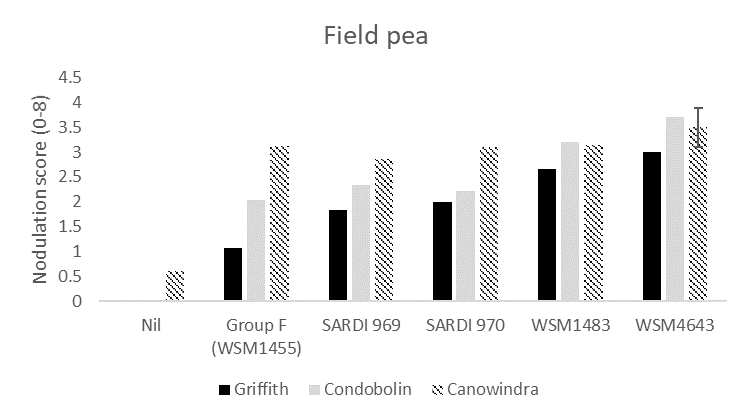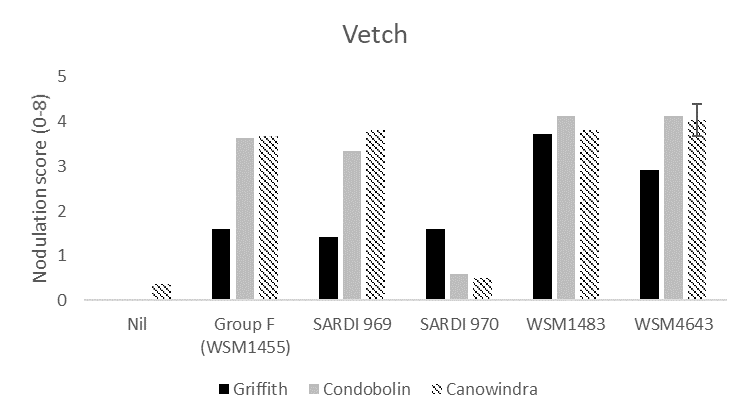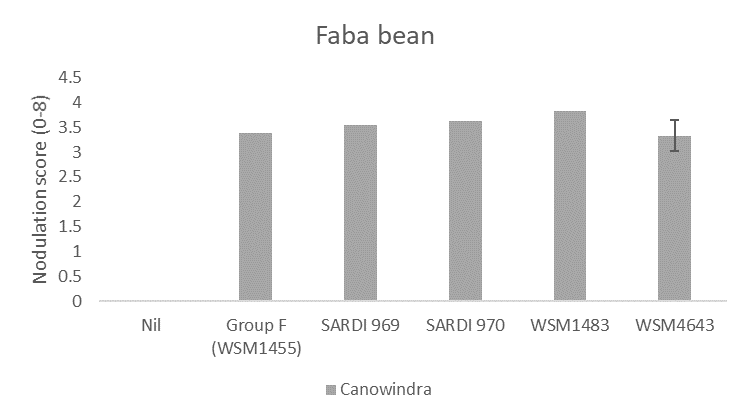Fixing more N by improving inoculant performance in sub-optimal conditions
Take home messages
- Rhizobia strains selected from soils with pH similar to those encountered across large areas of central and southern NSW have increased nodulation in lentil, field pea and vetch compared to the current Group F strain
- > 40% of paddocks surveyed in the GRDC northern region covering central and southern NSW had a pHCa < 5.0
- While acid tolerant rhizobia may improve nodulation in acidic soils, consideration to amelioration acidity should be given where pHCa <5.0 as nodulation is likely to still be inadequate at this pH.
Background
There are three key considerations in achieving successful nodulation of legumes. Firstly, the host plant needs to be suited to the conditions in which it is grown. Secondly, there needs to be a sufficient number of a compatible strain of rhizobia for the host plant. Thirdly, there needs to be capacity for communication (signalling) between the host plant and the rhizobia for root infection and nodulation to occur. Suboptimal conditions including soil acidity, aridity, low clay content of soil, inadequate nutrient availability (for the host plant and the rhizobia) and/or the presence of herbicide residues can impact the host plant, the rhizobia and/or the interaction of plant and rhizobia thus reducing the formation of an effective symbiosis and reducing potential nitrogen fixation. Nodulation and nitrogen fixation are not a given when growing legumes. Legumes that don’t form an effective symbiosis use nitrogen (N) from the soil pool rather than contributing to building soil N.
So what is the current situation and probable impediments to achieving higher nitrogen fixation in legumes and what options are there to improve the situation? In the remainder of this paper we will discuss current research underway to deliver more resilient rhizobia strains for lentil, faba bean, field pea and vetch to the marketplace along with other facets of management that need to be considered to improve legume performance.
The search for more resilient, robust rhizobia strains
Current recommendations suggest lentil and faba bean are inoculated with Group F (containing the rhizobia strain WSM1455) while field pea and vetch are inoculated with Group E (SU303). However, the current Group E is difficult to manufacture and as a result, field pea and vetch are in fact inoculated with Group F inoculant. Fortunately, the current rhizobia strain (WSM1455) used in Group F inoculant has good compatibility across all of these host legumes. However, the current Group F which was isolated from soil in Greece (pHCa 8.0) and released in 2002, exhibits a rapid decline in capacity to nodulate plants where pHCa < 6.0, with plants generally inadequately nodulated where pHCa <5.0 (Yates et al. 2016; Ballard et al. 2019).
Large areas of cropping land in central and southern NSW have soils where the capacity of the current Group F to effectively nodulate host plants is restricted. A recent survey of 150 commercial paddocks in the GRDC northern region found that soil pH in the top 20 cm of the soil profile would likely restrict the performance of the current Group F in ≥ 40% of paddocks sampled (Table 1). Rhizobia with greater acid soil tolerance would likely increase capacity for nitrogen fixation throughout the regions sampled in this survey.
Table 1. The average soil pHCa of 150 commercial paddocks in the central east, central west, south east or south west regions of the GRDC northern region as sampled in 2019 and the percentage of paddocks where soil pH was less than 5.0.
Depth | Average soil pHCa | Percentage of paddocks pHCa<5.0 |
|---|---|---|
0-5 cm | 5.3 | 39 |
5-10 cm | 5.0 | 84 |
10-20 cm | 5.6 | 40 |
20-30 cm | 6.1 | 15 |
Both Murdoch University (Centre for Rhizobium Studies) and SARDI have been isolating rhizobia suitable for consideration as a Group F replacement from acidic soils (pHCa 4.5-5.5); Murdoch University accessions have been sourced from Italy and SARDI accessions from commercial paddocks in South Australia. Preliminary glasshouse and field studies in Western Australia identified two acid-tolerant Italian strains (WSM1455, WSM4643) which produced improved nodulation, nitrogen fixation and grain yield in field pea (Yates et al. 2017). Similar studies in South Australia reported improved performance in lentil and faba bean where acid tolerant Australian strains (SRDI969, SRDI970) were used compared to the current Group F (WSM1455) strain (Ballard et al. 2019). These results are encouraging. However, to be considered for commercial release, it is important that any potential strain has capacity to improve nodulation across the entire Group F host range which also includes vetch. In addition, any elite strain has to be able to be manufactured easily and to remain stable up until the point of use at sowing.
In 2019, field testing of the four elite acid-tolerant strains commenced in the Northern GRDC region with sites sown at Griffith, Condobolin and Canowindra. The objective of the three sites was to evaluate the performance of the elite strains in differing soils (Table 2) and under varying climatic conditions. Griffith was the most challenging of the sites due to lower soil pH, low clay content and high summer temperatures. Canowindra with a higher soil pH, higher clay content and lower temperatures potentially increased survival capacity of the rhizobia, although such conditions also increase the potential for higher background rhizobia levels that compete with introduced strains.
Table 2. The location, soil pH and texture of three sites used for evaluation of elite rhizobia strains for lentil, faba bean, field pea and vetch in the GRDC Northern Region in 2019.
Location | Soil pHCa (0-10 cm) | Soil texture |
|---|---|---|
Griffith | 4.6 | Light sandy loam |
Condobolin | 4.8 | Sandy loam (red chromosol) |
Canowindra | 5.1 | Loam (dermosol) |
For lentils, there was a significant difference in nodulation across sites and due to rhizobia strain (Figure 1). The most acidic site, Griffith, had lower nodulation than all other sites and only WSM4643 produced a significantly higher nodulation score than the current Group F strain. At Condobolin and Canowindra, both WSM1483 and WSM4643 produced significantly higher nodulation scores than the current Group F, while SRDI969 was also significantly higher than the current Group F at Canowindra. None of the strains at any site gave an overall nodulation score that is considered adequate (score ≥ 4; Yates et al. 2016).
 Figure 1. The average nodulation score of 15 lentil plants at Griffith, Condobolin and Canowindra where seed was inoculated with peat slurry containing a no rhizobia (nil), the current Group F strain, or one of four experimental strains. A score of 4 is considered adequate under the system developed by Yates et al. (2016).
Figure 1. The average nodulation score of 15 lentil plants at Griffith, Condobolin and Canowindra where seed was inoculated with peat slurry containing a no rhizobia (nil), the current Group F strain, or one of four experimental strains. A score of 4 is considered adequate under the system developed by Yates et al. (2016).
For field pea, all experimental strains produced significantly greater nodulation than the current Group F at Griffith (Figure 2). At Condobolin and Canowindra, WSM4643 produced significantly higher nodulation score than the current Group F, with WSM1483 also significantly higher at Condobolin.
 Figure 2. The average nodulation score of 15 field pea plants at Griffith, Condobolin and Canowindra where seed was inoculated with peat slurry containing a no rhizobia (nil), the current Group F strain, or one of four experimental strains. A score of 4 is considered adequate under the system developed by Yates et al. (2016).
Figure 2. The average nodulation score of 15 field pea plants at Griffith, Condobolin and Canowindra where seed was inoculated with peat slurry containing a no rhizobia (nil), the current Group F strain, or one of four experimental strains. A score of 4 is considered adequate under the system developed by Yates et al. (2016).
For vetch, WSM1483 and WSM4643 produced significantly higher nodulation than the current Group F at Griffith and Condobolin (Figure 3). None of the experimental strains produced significantly higher nodulation than the current Group F at Canowindra. SRDI970 showed poor compatibility with vetch at Condobolin and Canowindra producing very low nodulation scores. It is critical that strains considered for potential release showed strong compatibility across the potential host range.
 Figure 3. The average nodulation score of 15 vetch plants at Griffith, Condobolin and Canowindra where seed was inoculated with peat slurry containing a no rhizobia (nil), the current Group F strain, or one of four experimental strains. A score of 4 is considered adequate under the system developed by Yates et al. (2016).
Figure 3. The average nodulation score of 15 vetch plants at Griffith, Condobolin and Canowindra where seed was inoculated with peat slurry containing a no rhizobia (nil), the current Group F strain, or one of four experimental strains. A score of 4 is considered adequate under the system developed by Yates et al. (2016).
Faba beans were grown only at Canowindra and there were no experimental strains that gave nodulation scores greater than those achieved by the current Group F strain (Figure 4).
 Figure 4. The average nodulation score of 15 faba bean plants at Canowindra where seed was inoculated with peat slurry containing a no rhizobia (nil), the current Group F strain, or one of four experimental strains. A score of 4 is considered adequate under the system developed by Yates et al. (2016).
Figure 4. The average nodulation score of 15 faba bean plants at Canowindra where seed was inoculated with peat slurry containing a no rhizobia (nil), the current Group F strain, or one of four experimental strains. A score of 4 is considered adequate under the system developed by Yates et al. (2016).
Samples were collected to determine nitrogen fixation and these are still undergoing processing as are samples collected to determine grain yield. However, based on results to date, it would appear that strains WSM1483 and WSM4643 offer considerable potential to increase nodulation in acidic soils and also have good compatibility with the potential host range. Research is ongoing within the Australian Inoculant Research Group to determine the manufacturability and stability characteristics of the elite strains, as this is a critical consideration in the practical delivery of elite strains to the marketplace.
Are elite strains the answer to increasing pulse production and adaptation?
The development of elite rhizobial strains is an important step forward in increasing pulse production, but it is not a silver bullet. Certainly, pulse production in central and southern NSW is likely to be constrained by acidic soils which are widespread throughout the region and our results indicate that elite strains may increase nodulation in these circumstances. The current strain of Group F was isolated from soils with a pH much higher than that encountered through much of the target growing regions of central and southern NSW and therefore strains selected from soils more comparable in pH are likely to have production and survival advantages. However, our results also show differences in host plant tolerance to soil acidity, with lentil nodulation still well below the level considered adequate even with acid tolerant rhizobia. Thus, soil acidity is potentially impacting the host plant and/or the formation of an effective symbiosis. So are tolerant host plants the answer? Potentially they are also a tool to improve adaptation and production of pulses in acid soil regions. However, what must be considered is that if the acid soil problem is not addressed, it will continue to worsen. The results of our soil survey show that a large percentage of commercial paddocks have soil pHCa<5.0. Acid tolerant rhizobia and acid tolerant host plants can only do so much and certainly once soil pH falls below 5.0, other problems come into play including reductions in the efficiency of use of applied nutrients. Also, the impact of herbicide residues needs to be considered as these can impact the host plant, rhizobia and the host plant-rhizobia symbiosis. This project is in its early stages and further evaluation is required through time and across sites to determine the impact that elite rhizobial strains may have on potential pulse production.
References
Ballard R, Farquharson E, Ryder M, Denton M, Rathjen J, Henry F, Brand J, Whitworth R, Haskins B, Seymour M, Yates R (2019) Fixing more N – improving the performance of rhizobial inoculants in suboptimal conditions. GRDC Updates.
Yates, RJ, Abadidoo, Howieson, JG (2016) Field experiments with rhizobia. In. Working With Rhizobia (Eds. JG Howieson, MD Dilworth). Australian Centre for International Agricultural Research and Centre for Rhizobium Studies Murdoch University.
Acknowledgements
The research undertaken as part of this project is made possible by the significant contributions of growers through both trial cooperation and the support of the GRDC, the author would like to thank them for their continued support. The authors also wish to acknowledge the financial and in-kind contributions of Local Land Services and Central West Farming Systems towards the soil survey results presented in this paper.
Contact details
Dr Belinda Hackney
NSW Department of Primary Industries
Pine Gully Rd, Wagga Wagga, NSW 2650
Ph: 0438 850 942
Email: belinda.hackney@dpi.nsw.gov.au
GRDC Project Code: DAN1901 002 RTX,
Was this page helpful?
YOUR FEEDBACK
